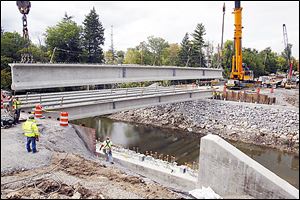
EDITORIAL
Driving Ohio
6/30/2013
Workers install a beam for a new bridge on Perrysburg-Holland Road last fall. Conditions of roads and bridges in the state are drawing attention.
Gov. John Kasich has moved aggressively to alleviate the poor condition of Ohio’s roads and bridges.
The governor’s transportation plan, effective July 1, calls for toll increases of 2.7 percent in each of the next 10 years on the Ohio Turnpike. The state will also do some borrowing and bonding.
Dozens of multimillion-dollar projects, mostly in northern Ohio, finally will be completed. The total bill: about $3 billion, roughly half of which will come from bonding.
Still, these efforts fall far short of what’s needed to build and maintain a first-class transportation system.
Fred Pausch, executive director of the County Engineers Association of Ohio, says Ohio has almost “an infinite need” to improve its roads and bridges.
“Infinite” is a big but fitting word; no part of the state is not in dire need of road and bridge repairs.
Mr. Pausch says that 6,000 county-maintained bridges need an added $770 million in repairs. Another report concludes that one in nine of Ohio’s bridges is “structurally deficient.”
Those problems will require a range of fixes — and the political will to carry them out — including raising the gas tax or replacing it.
The state has formed a task force on these issues composed of three members each from the state House and Senate. The task force must release recommendations by Dec. 15, 2014.
Many states are in the same boat as Ohio, because the federal government is not spending enough money on infrastructure — dollars that would create jobs and stimulate the economy.
Virginia replaced its gasoline per-gallon tax. It raised the state sales tax and the tax on auto sales to do road and bridge repairs. That hits the working-class hard.
Maryland is indexing the gas tax and transit fares to inflation. That state also has a 3 percent sales tax at the pump. All that will net $4.4 billion for roads and bridges.
There is no painless way to rebuild Ohio’s infrastructure. With increasingly fuel-efficient vehicles, relying on the gas tax has many drawbacks. But until government can find and carry out a better alternative — maybe an odometer tax — fuel taxes are the best available option. Other interim possibilities include raising sales taxes on high-powered gas guzzlers.
Leaders such as Mr. Kasich must start thinking about alternatives. Long-range, the fuel tax is an inadequate and unreliable way to pay for transportation needs, but changing to another system could take years. Ohio can’t afford to let its roads and bridges deteriorate further.
The governor deserves credit for his leadership on this issue. But he will have to do a lot more to find practical and fair ways to raise revenue for Ohio’s 21st century transportation needs.